Historical events have played a role in developing Ireland’s linguistic landscape. The modern-day city of Dublin started as a Celtic settlement called Áth Cliath, and many peoples have since called the region home. Drawn by water access, the Vikings established Dubh Linn as a trading center along the River Liffey.1 Subsequent ruling by other groups, including the Normans and the English, further shaped the city’s development.1,2 Dublin became a focal point of political power, and as the center of English administration was at the heart of Ireland’s struggle for independence.2 Stability in the Republic and economic boon in the city fostered Dublin’s transition to the world-renowned city it is today.2 Ireland is multilingual, with English as its primary language, and traditional Irish, Gaelige, recognized as an official language. The preservation of the Irish language began as a nationalist movement in the 19th century and today differentiates Ireland from other English-speaking cultures, helping to secure its independent role in Europe.3 The inclusion of Irish language on signs throughout the country is not a result of commodification but a means of preserving culture beyond simply symbolic or tourist-based conventions.
LINGUISTIC LANDSCAPE OF DUBLIN
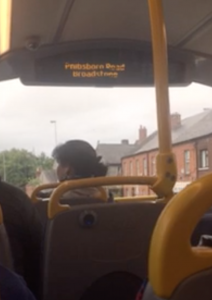
English and Irish are both observed when traveling through Ireland, with both languages used on street signs, trash bins, parks and bus stops. When I journey into the city, the bus announces each stop in both English and Irish. In cultural geography, landscapes are characterized as “representations of spaces that privilege particular subject positions and points of view.”4 Considering this, the Irish landscape is one that privileges both English and Irish equally. Most signs display an Irish message with an English translation underneath. The same content is conveyed in both languages on a single sign and Irish never has a purely symbolic function.
These signs are all public signs, showing that use of Irish within the landscape is often an “artifact of state-driven processes.”4 Within Dublin, privately-owned shops tend to only use English and Gaelige is rarely used conversationally, although this does not hold true for the rest of Ireland.
TOURISM AND CITY CENTRE
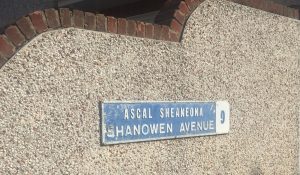
Throughout Dublin, signs are located on walls along streets with the exception of City Centre which has signs more similar to the fingerposts used in the UK. The City Centre signs are the closest in the landscape to a commodification of the Irish language. These signs direct tourists to city sights in both English and Irish, ensuring that visitors get a taste of Irish culture.
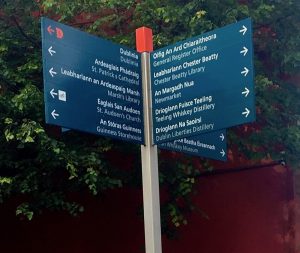
However, considering that street signs throughout the country also contain both languages, the use of Irish in City Centre cannot be tied solely to commercialization. Other elements of language in City Centre contribute more to the commodification of Irish culture, such as pubs in Temple Bar that promote traditional Irish music, or the encouragement of Guinness Storehouse visitors to join in the traditional cheer, sláinte, while learning how to correctly taste Guinness.
GAELIGE THROUGHOUT IRELAND
In other areas of Ireland, the Irish language is preserved beyond city signs and tourism. In West Ireland, around 50% of the population can speak Gaelige compared to 30% in Dublin.5 When visiting Galway, I toured Inisheer Island with a native speaker as my guide. He knew limited English in order to make a living and discussed the importance of Irish to the identity of local communities. When he wasn’t sharing facts about the island, he was singing traditional Irish songs, an experience far more authentic than the tourist-oriented pubs in Dublin.
Considering the linguistic landscape of Ireland, the use of Gaelige has helped preserve Irish culture even without the language being commonly spoken. W.B. Yeats famously said that his language was Irish, while acknowledging that he could not speak the language.3 This sentiment of identity with the language and what it stands for is shared by many throughout Ireland. Unlike the branding in Washington DC’s Chinatown that “resulted in a commodification of ethnicity as well as the delinking of Chinese writing from Chinese people, culture or history,”4 the use of Gaelige has strengthened Irish culture and identity throughout Ireland and will hopefully continue to do so for years to come.
WORKS CITED
- “Dublin: A Short History.” The National Archives of Ireland, Census of Ireland, www.census.nationalarchives.ie/exhibition/dublin/short_history.html
- “A Brief History of Dublin, Ireland.” Dublin.Info, 2013, www.dublin.info/history/
- Tymoczko, Maria, and Colin Ireland. “Language and Identity in Twentieth-Century Ireland.” Éire-Ireland: a Journal of Irish Studies, vol. 38, no. 1-2, pp. 4–22., doi:10.1353/eir.2003.0012
- Leeman, Jennifer, and Gabriella Modan. “Commodified Language in Chinatown: A Contextualized Approach to Linguistic Landscape.” Journal of Sociolinguistics, vol. 13, no. 3, May 2009, pp. 332–362., doi:10.1111/j.1467-9841.2009.00409.x
- “Irish Language and the Gaeltacht .” An Phríomh-Oifig Staidrimh, Central Statistics Office, 11 July 2018, www.cso.ie/en/releasesandpublications/ep/p-cp10esil/p10esil/ilg/
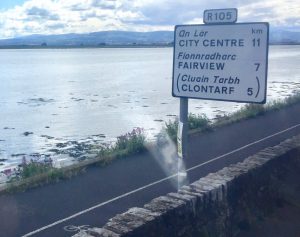
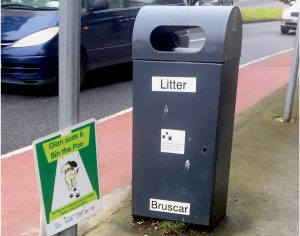
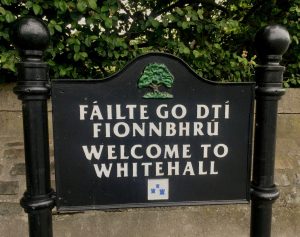
Wow, the difference between public signs versus privately-owned shops, and the difference is Gaelige speakers too! I find it interesting that, in Dublin, the use of Irish is directed in equal parts to tourists and to locals.
Hey Katelyn,
This post is honestly so thorough and informational in its depiction of Dublin’s linguistic landscape. I agree with you that Irish culture and language remains strong in the modern day. However, I wonder if the international trend towards globalization, Ireland’s strong relationship with the EU, and the potential new changes due to Brexit will affect its continued use of its native tongue. Conflict over the Irish language is nothing new to this country, but the future for Ireland as well as other European nations remains an enigma.
Hi Katelyn, this is a really interesting introduction to Dublin and Ireland in general. I used to think that Ireland was pretty much the same as the UK where there was only one language but I learned a lot more about the linguistic landscape and culture about Ireland from this essay. I hope the Irish could preserve their identity in the trend of globalization and merging.
I loved the pictures! In this essay you really explored different mediums and different reflections of culture experienced, and also how you explored the usage of the Irish language. I wonder if the usage and the role it plays within society differs around different cities around Ireland/outside Dublin.